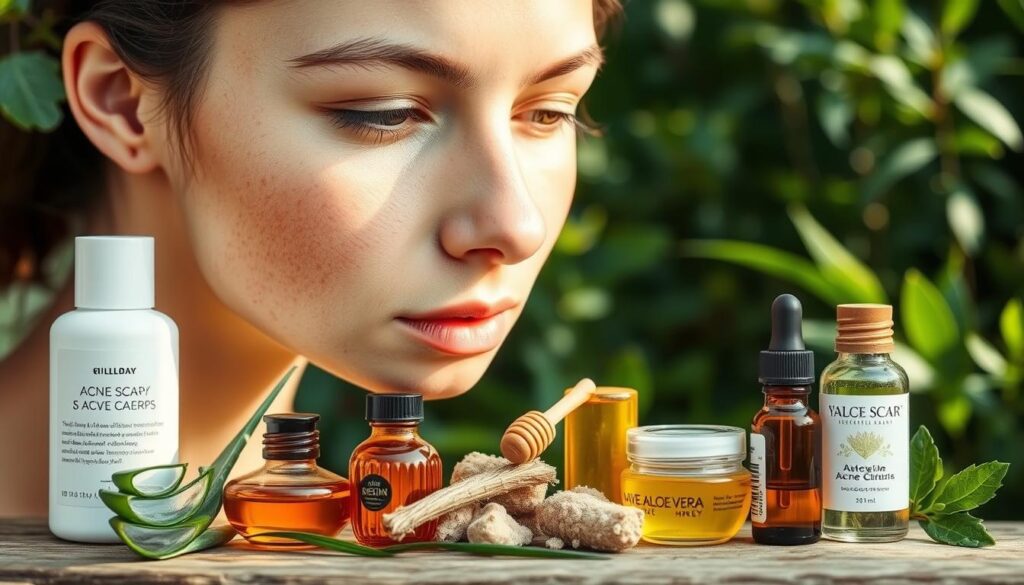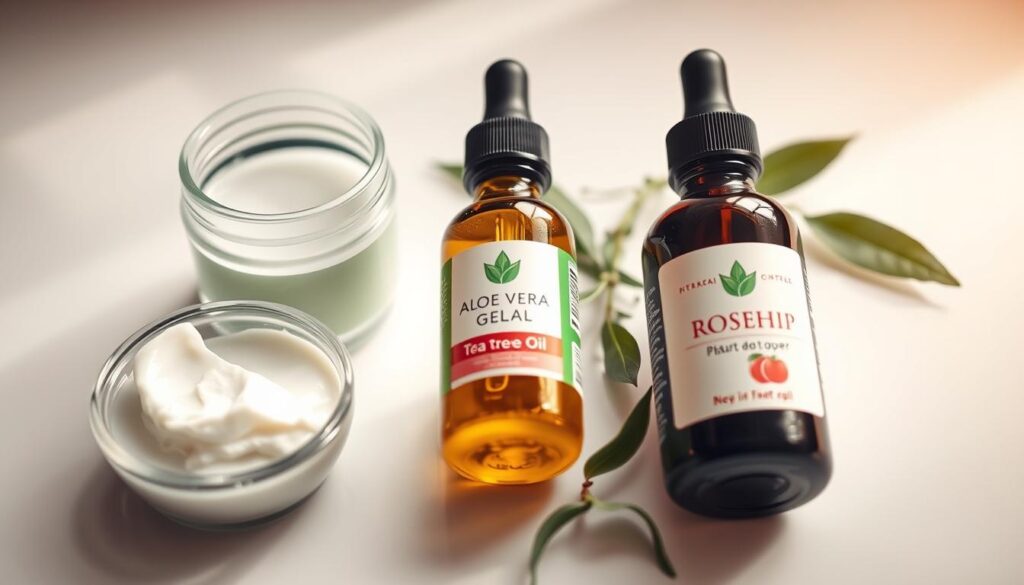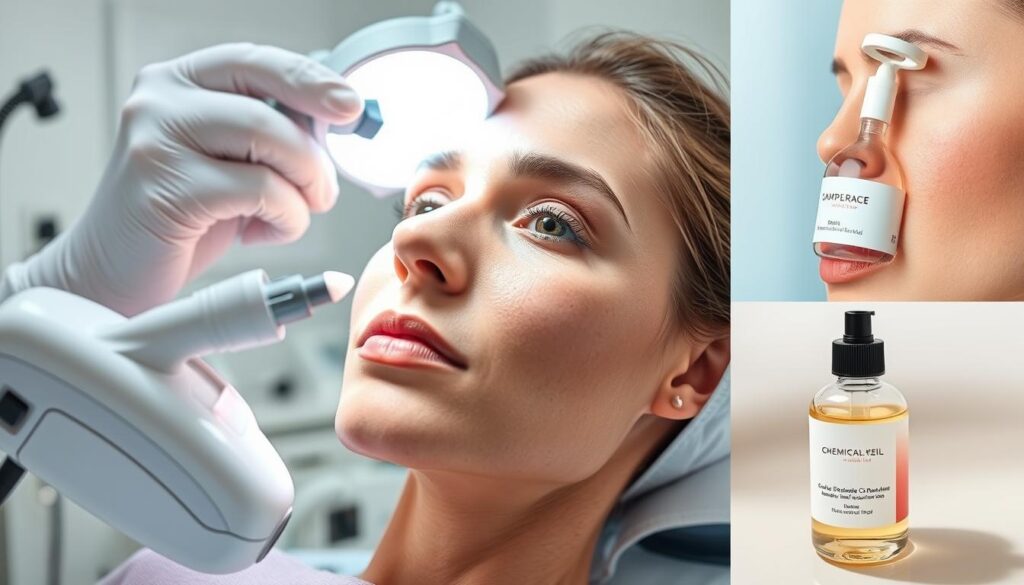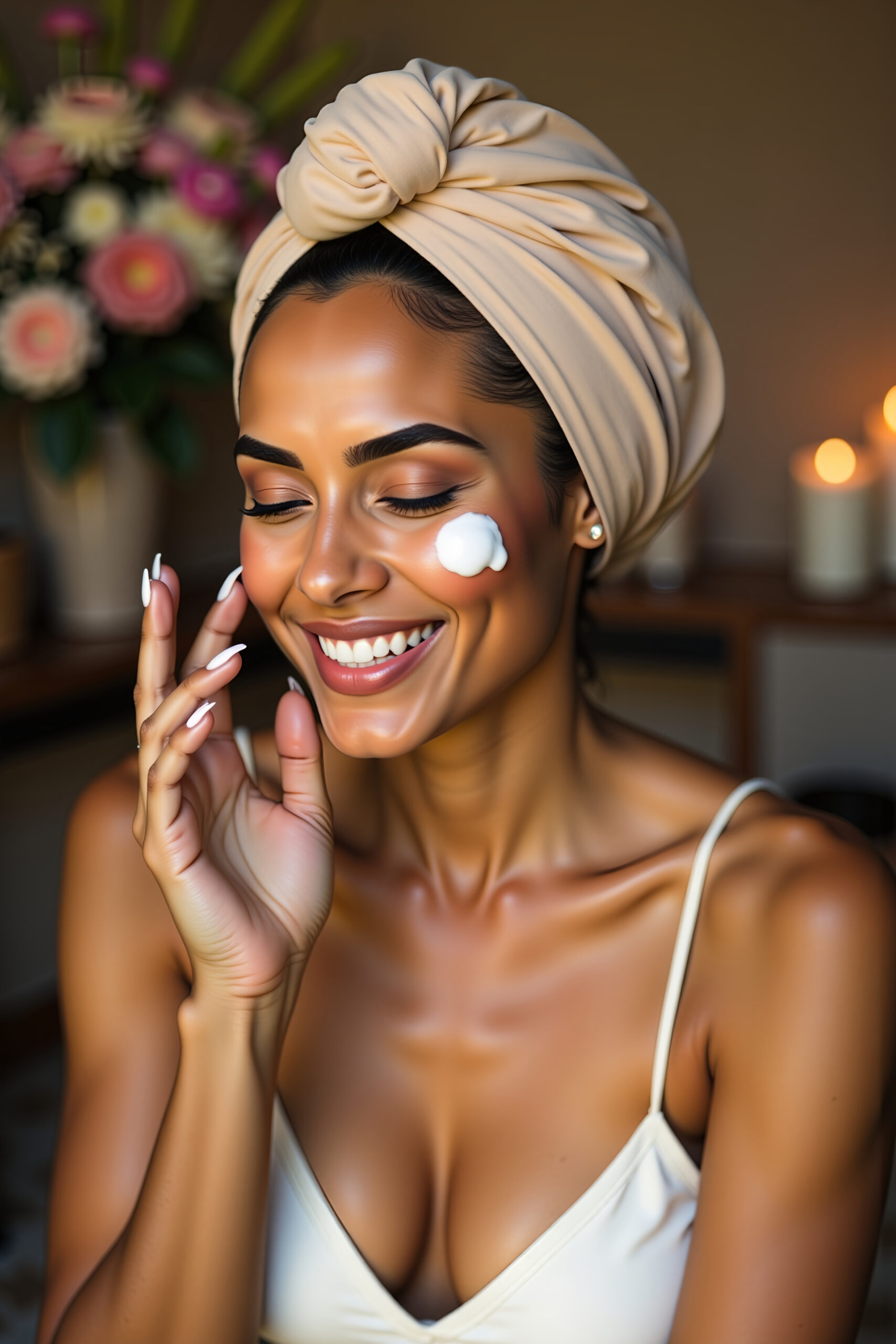Table of Contents
Dealing with acne scars can feel like a never-ending battle. Whether they’re mild marks or deeper indentations, these reminders of past breakouts can affect your confidence. But here’s the good news: you don’t need harsh treatments to see results. Natural, dermatologist-approved methods can help your skin heal safely and effectively.

Unlike aggressive procedures, natural solutions focus on nurturing your skin over time. From gentle exfoliation to protecting your face from the sun, these methods are designed to restore your skin’s health without irritation. Plus, they’re accessible and easy to incorporate into your daily routine.
In this guide, we’ll walk you through proven techniques to reduce the appearance of scars caused by acne. Whether you’re just starting your journey or looking for new ideas, we’ve got you covered. Let’s dive into a natural approach to clearer, healthier skin.
Key Takeaways
- Natural methods are safe and effective for treating acne scars.
- Dermatologist-approved techniques ensure credibility and accessibility.
- Gentle care can help your skin heal without irritation.
- Protecting your skin from the sun is crucial for scar reduction.
- This guide offers practical advice for all types of scars.
Understanding Acne Scars and Their Types
Not all acne scars are the same, and knowing their types can guide your healing journey. These marks are the result of your skin’s natural healing process after inflammation. Depending on how your skin repairs itself, scars can appear as depressions or raised areas. Understanding these differences is key to choosing the right treatment.
Atrophic Scars: Icepick, Rolling, and Boxcar
Atrophic scars are depressions in the skin caused by a loss of tissue. They are the most common type of acne scar. Icepick scars are narrow and deep, resembling small punctures. Rolling scars have a wavy texture, creating an uneven surface. Boxcar scars are wider with sharp edges, often appearing like craters.
These scars form when the skin’s deeper layers are damaged during healing. The lack of collagen production in the affected area leads to the sunken appearance. Identifying the specific type of atrophic scar helps in tailoring the right treatment approach.
Raised Scars: Hypertrophic and Keloid Explained
Unlike atrophic scars, raised scars occur when the skin produces too much collagen during healing. Hypertrophic scars are thick and raised but stay within the boundaries of the original wound. Keloid scars, on the other hand, extend beyond the wound area and can grow larger over time.
Both types of raised scars are caused by an overactive healing response. Keloids are more common in individuals with darker skin tones and can be more challenging to treat. Understanding these differences helps in managing expectations and selecting appropriate treatments.
The way your skin heals plays a significant role in scar formation. Factors like fibroblast production and the depth of the wound affect the final appearance. By understanding the type of scar you have, you can explore products and treatments that target your specific needs.
Recognizing Post-Acne Marks and Hyperpigmentation
After a breakout, your skin might leave behind reminders that aren’t true scars. These marks, often mistaken for permanent damage, are usually temporary and fade over time. Understanding the difference between post-acne marks and scars is crucial for choosing the right treatment.

Dark Spots, Red Marks, and Inflammation
Post-acne marks come in two main forms: dark spots and red marks. Dark spots, also known as post-inflammatory hyperpigmentation, occur when your skin produces excess melanin during the healing process. This overproduction is often triggered by inflammation caused by acne.
Red marks, on the other hand, are the result of increased blood flow to the affected area. These marks typically fade as your skin heals, but they can linger for weeks or even months. Unlike scars, these marks don’t involve structural changes to the skin.
Darker skin tones are more prone to hyperpigmentation due to higher melanin levels. This means that dark spots may appear more pronounced and take longer to fade. Knowing your skin type helps in selecting the right approach to reduce their appearance.
- Post-acne marks are temporary, while scars involve permanent changes to the skin’s structure.
- Dark spots form due to melanin overproduction caused by inflammation.
- Red marks result from increased blood flow and fade as the skin heals.
- Darker skin tones may experience more noticeable hyperpigmentation.
- Distinguishing between marks and scars is essential for effective treatment.
By understanding the nature of these marks, you can take steps to reduce their appearance and promote healthier skin. In the next sections, we’ll explore natural remedies and treatments tailored to your specific needs.
Natural Remedies for Clear, Glowing Skin
Achieving clear, glowing skin doesn’t require expensive treatments—nature has plenty to offer. From nourishing oils to soothing gels, these remedies are gentle yet effective. They support your skin’s natural healing process while improving texture and tone. Let’s explore some of the best options you can easily incorporate into your routine.
Home Remedies: Black Seed Oil, Rosehip Oil, and Honey
Black seed oil is a powerhouse for skin health. Packed with antioxidants, it helps reduce discoloration and promotes healing. Rosehip oil, rich in essential fatty acids, works to even out skin tone and improve elasticity. Both oils are lightweight and absorb quickly, making them ideal for daily use.
Honey, a natural humectant, locks in moisture and soothes irritation. Its antibacterial properties also help prevent breakouts. These ingredients are perfect for those seeking gentle yet effective care for their skin.
Benefits of Aloe Vera and Apple Cider Vinegar
Aloe vera is a go-to for skin healing. It boosts collagen production, which helps smooth out uneven texture. Its cooling effect also reduces redness and inflammation, making it a great choice for sensitive skin.
Apple cider vinegar contains lactic acid, which gently exfoliates the top layer of dead skin cells. This reveals a brighter, more even complexion. Always dilute it with water to avoid irritation and patch test before use.
- Black seed oil and rosehip oil reduce discoloration and improve skin elasticity.
- Honey soothes and hydrates while preventing breakouts.
- Aloe vera promotes collagen production and reduces redness.
- Apple cider vinegar gently exfoliates for a brighter complexion.
- These natural remedies are easy to use and effective for all skin types.
Incorporating these natural products into your routine can transform your skin’s health and appearance. They’re affordable, accessible, and free from harsh chemicals. Give your body the care it deserves with these dermatologist-approved solutions.
Proven Methods to Get rid of acne scars
Finding effective solutions for skin imperfections can transform your confidence. Whether you’re dealing with mild marks or deeper indentations, there are proven methods to help. These treatments, approved by dermatologists, focus on renewing your skin’s health and improving its texture.

Topical Treatments: Salicylic Acid and Retinoids
Topical treatments are a great starting point for addressing skin concerns. Salicylic acid is a beta hydroxy acid that exfoliates the skin’s surface, helping to unclog pores and reduce discoloration. It’s particularly effective for treating mild marks and preventing future breakouts.
Retinoids, derived from vitamin A, are another powerful option. They speed up cell turnover, promoting the growth of new, healthy skin. Over time, retinoids can smooth out uneven texture and improve the skin’s overall appearance. Always start with a lower concentration to avoid irritation.
Exfoliating Acids: AHAs and Lactic Acid
Exfoliating acids like alpha hydroxy acids (AHAs) and lactic acid work wonders for renewing the skin’s outer layer. AHAs, such as glycolic acid, gently remove dead skin cells, revealing a brighter complexion. They also stimulate collagen production, which helps reduce the appearance of deeper marks.
Lactic acid is a milder option, making it ideal for sensitive skin. It hydrates while exfoliating, leaving your skin soft and smooth. Regular use of these acids can significantly improve skin texture and tone.
| Treatment | Benefits | Best For |
|---|---|---|
| Salicylic Acid | Exfoliates, unclogs pores, reduces discoloration | Mild marks, oily skin |
| Retinoids | Speeds cell turnover, smooths texture | Uneven texture, aging skin |
| AHAs | Brightens, stimulates collagen | Dull skin, fine lines |
| Lactic Acid | Hydrates, gently exfoliates | Sensitive skin, dryness |
For those with darker skin, it’s essential to approach treatments with care. Some acids and procedures can cause hyperpigmentation if not used correctly. Always consult a dermatologist to tailor a plan that suits your skin type and concerns.
Professional procedures like chemical peels and laser treatments can also be effective. These methods target deeper layers of the skin, promoting significant improvement. However, they require professional supervision to ensure safety and optimal results.
By combining these treatments with a consistent skincare routine, you can achieve smoother, healthier skin. Remember, patience is key—results take time, but the effort is worth it.
At-Home Skincare Routine for Scar Prevention
Building a simple yet effective skincare routine can make a world of difference in preventing skin imperfections. A consistent regimen not only keeps your skin healthy but also minimizes the risk of long-term damage. Let’s break down the essentials for a routine that works.
Gentle Cleansing and Daily Moisturizing
Start with a gentle cleanser that removes dirt and oil without stripping your skin of its natural moisture. Look for non-comedogenic products that won’t clog your pores. Cleansing twice a day helps maintain a clear and balanced complexion.
After cleansing, apply a lightweight moisturizer to keep your skin hydrated. Dry skin can exacerbate the appearance of uneven texture, so daily moisturizing is key. Choose a formula that suits your skin type for the best results.
Importance of Sunscreen and UV Protection
Never skip sunscreen—it’s your skin’s best defense against harmful UV rays. Sun exposure can darken existing marks and slow down the healing process. Apply a broad-spectrum SPF 30 or higher every morning, even on cloudy days.
Reapply sunscreen every two hours if you’re spending time outdoors. This simple step protects your skin from damage and helps maintain its natural radiance. Pair it with a hat or sunglasses for extra care.
- Use a gentle cleanser to keep pores clear without irritation.
- Moisturize daily to maintain smooth and hydrated skin.
- Apply sunscreen every morning to protect against UV damage.
- Choose non-comedogenic products to prevent clogged pores.
- Consistency is key—stick to your routine for the best results.
By following these steps, you can create a skincare routine that not only prevents imperfections but also promotes a healthy, glowing complexion. Remember, consistency and patience are your allies in achieving long-term results.
Medical and In-Office Treatments for Acne Scar Reduction
When natural remedies aren’t enough, advanced medical treatments can offer significant results. These treatments, performed by dermatologists, target deeper layers of the skin to improve texture and tone. Whether you’re dealing with raised scars or uneven texture, these procedures provide precision and effectiveness.

Chemical Peels, Microneedling, and Injections
Chemical peels use acids to exfoliate the top layer skin, revealing smoother, healthier skin underneath. They’re particularly effective for mild to moderate imperfections. Microneedling, on the other hand, involves tiny needles that stimulate collagen production, helping to repair damaged tissue.
For raised scars, corticosteroid injections can flatten the area and reduce inflammation. These treatments are quick and often require multiple sessions for optimal results. Always consult a dermatologist to determine the best approach for your skin type.
Laser Treatments and Dermal Fillers
Laser treatments are highly effective for reducing the appearance of deeper marks. They work by targeting the affected area with concentrated light, promoting skin renewal. Dermal fillers, meanwhile, plump up depressed areas, creating a smoother surface.
Both procedures require professional supervision to ensure safety and effectiveness. Recovery time varies, but most patients see noticeable improvements within weeks. Post-procedure creams and products can help minimize irritation and support healing.
| Treatment | Benefits | Recovery Time |
|---|---|---|
| Chemical Peels | Exfoliates, improves texture | 3-7 days |
| Microneedling | Stimulates collagen, repairs tissue | 2-3 days |
| Laser Treatments | Reduces deep marks, renews skin | 1-2 weeks |
| Dermal Fillers | Plumps depressed areas | Minimal |
These advanced treatments can significantly help reduce the appearance of stubborn marks. By combining them with a consistent skincare routine, you can achieve smoother, healthier skin. Remember, patience and professional guidance are key to success.
Lifestyle Changes to Support Skin Healing
Healthy skin starts with more than just products—it’s about your daily habits. While treatments and creams play a role, your lifestyle can significantly impact how your skin heals. Simple adjustments, like managing stress and staying consistent with your routine, can make a big difference over time.
Stress Management and Consistent Skincare Habits
Stress is a major factor that can slow down your skin’s recovery. When you’re stressed, your body produces cortisol, which can worsen inflammation and delay healing. Finding ways to manage stress, like meditation or regular exercise, can help your skin recover more effectively.
Consistency is also key. A regular skincare routine ensures your skin gets the care it needs daily. Cleansing, moisturizing, and protecting your skin from the sun are essential steps that support long-term improvement.
Practical Lifestyle Adjustments
Dermatologists recommend several lifestyle changes to support tissue repair and overall skin health. These include eating a balanced diet rich in antioxidants, staying hydrated, and getting enough sleep. These habits provide your skin with the nutrients it needs to heal and stay healthy.
It’s also important to allow sufficient time for treatments to work. Sometimes, it can take months to see the full benefits. Patience and persistence are crucial for achieving the best results.
| Lifestyle Change | Benefits |
|---|---|
| Stress Reduction | Reduces inflammation, supports healing |
| Balanced Diet | Provides essential nutrients for skin repair |
| Hydration | Keeps skin moisturized and healthy |
| Consistent Routine | Maintains skin health and prevents scarring |
By combining these lifestyle changes with professional treatments, you can create a holistic approach to skincare. Remember, daily maintenance is just as vital as any procedure. Together, these steps can help you achieve smoother, healthier skin over time.
Conclusion
Taking care of your skin after breakouts requires a mix of patience and the right approach. Whether you’re dealing with temporary marks or deeper changes, there are effective ways to improve your skin’s appearance. From natural remedies like aloe vera to professional treatments such as peels and laser therapy, the options are diverse and tailored to your needs.
Building collagen and repairing tissue takes time, but consistent care can make a significant difference. Protecting your skin from the sun and maintaining a healthy lifestyle are just as important as the treatments you choose. For those with darker skin, consulting a dermatologist ensures safe and effective results.
Remember, improving your skin’s appearance is a journey. By combining natural methods with professional guidance, you can help reduce the impact of past breakouts and achieve a smoother, healthier complexion. Patience and persistence are your best allies in this process.




